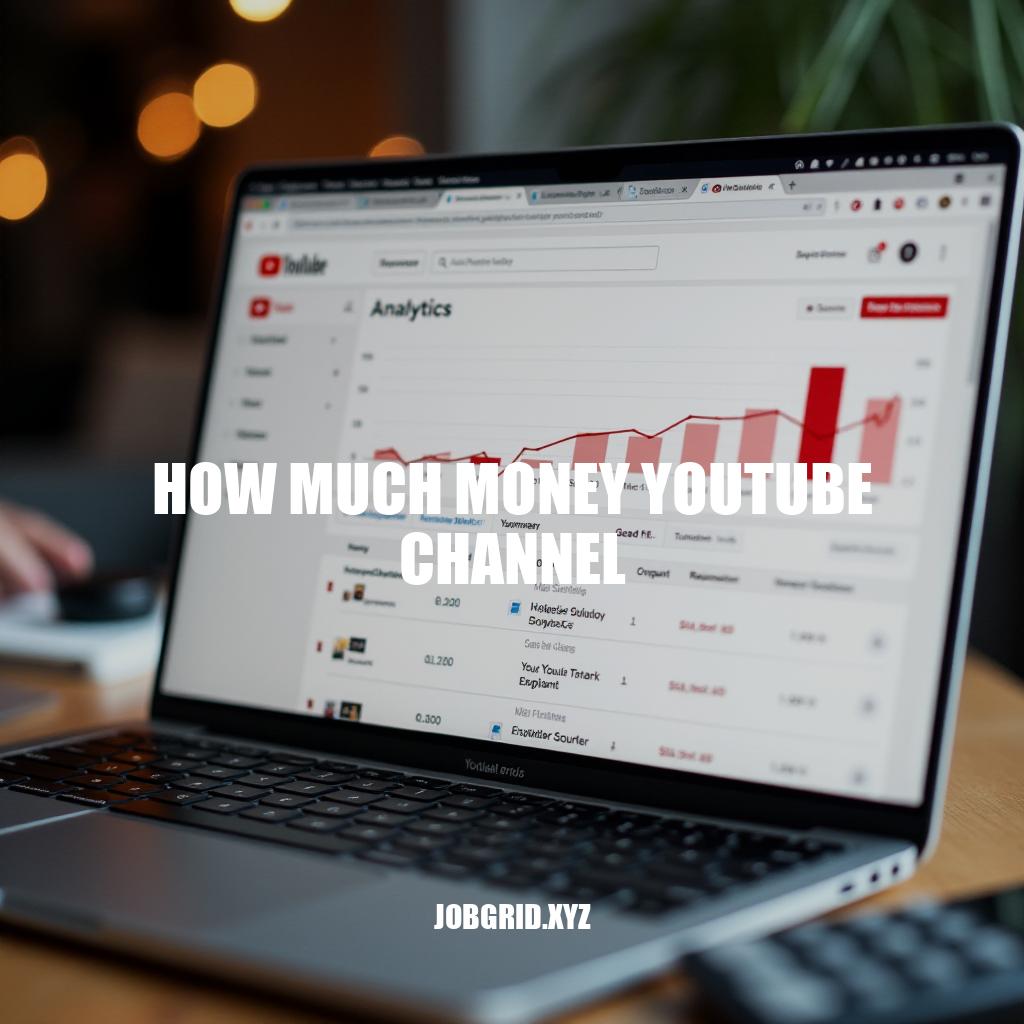
In today’s digital age, the financial prospects of YouTube channels have become a fascinating topic for content creators and entrepreneurs alike. With the explosion of online video consumption, understanding how YouTube monetization works can unveil numerous opportunities for earning revenue. From ad revenues to brand partnerships and merchandise sales, a successful YouTube channel can turn into a lucrative venture, rivaling traditional career paths.
Let’s dive into the various streams of income that YouTube offers and explore what it takes to maximize earnings from this platform.
Factors Influencing Earnings
Key Factors Affecting YouTube Channel Earnings
1. Views
The number of views your videos receive is the most fundamental factor. Each view represents a potential ad impression, which directly contributes to revenue.
Higher view counts increase ad impressions, leading to more earnings from ad revenue.
2. Ad Revenue
YouTube uses the AdSense program to display ads on your videos. Earnings from ad revenue depend on factors like:
-
Cost Per Mille (CPM): The amount an advertiser pays for 1,000 views of their ad.
-
Ad Types: Skippable, non-skippable, display ads, overlay ads, and bumper ads, each with different payout rates.
-
Viewer Demographics: Advertisers pay more to target specific demographics.
3.
Watch Time
The total amount of time viewers spend watching your videos influences YouTube’s algorithm, which can lead to better placement in search results and recommendations, indirectly boosting ad revenue and view counts.
4. Engagement Metrics
Likes, comments, shares, and subscriber growth signal to YouTube that your content is engaging, increasing its reach and potential earnings.
5. Sponsorships and Brand Deals
Brands pay creators to promote their products or services.
The payout varies greatly based on the creator’s niche, audience size, engagement rates, and the brand’s budget.
6. Channel Memberships and Super Chat
Creators can enable channel memberships, where subscribers pay a monthly fee for exclusive content or perks. During live streams, viewers can use Super Chat to tip creators, which also generates revenue.
7.
Affiliate Marketing
Promoting products and earning a commission on sales through affiliate links integrated into video descriptions or spoken endorsements.
8. Merchandise Sales
Selling branded merchandise like clothing, accessories, or digital products through platforms integrated with YouTube, like Teespring.
9. Crowdfunding
Platforms like Patreon allow fans to support creators with regular contributions in exchange for exclusive content or perks.
10.
YouTube Premium Revenue
Subscribers to YouTube Premium pay to watch videos without ads. A portion of their subscription fee is distributed to creators based on the watch time of their videos.
To maximize earnings, successful YouTubers often leverage a combination of these revenue streams, diversifying income sources to reduce dependency on any single factor.
Ad Revenue Breakdown
YouTube channels earn money from advertisements through various ad formats, each with its own revenue metrics. Here are the main types of ads and typical revenue metrics:
Types of Ads
-
Skippable In-Stream Ads: These ads appear before or during a video and viewers can skip them after 5 seconds. Advertisers only pay if the viewer watches the ad for at least 30 seconds or interacts with it.
-
Non-Skippable In-Stream Ads: These ads must be watched before the main video starts.
They are typically 15 or 20 seconds long.
-
Bumper Ads: Short, non-skippable ads that are up to 6 seconds long. They appear before the main video.
-
Mid-Roll Ads: These ads are inserted in the middle of a video for videos longer than 8 minutes. Creators can choose to manually or automatically insert these ads.
-
Overlay Ads: These ads appear on the lower 20% of the video.
However, YouTube has phased out overlay ads since April 2023.
-
Discovery Ads: These ads appear in YouTube search results and other relevant locations.
Revenue Metrics
-
CPM (Cost Per Mille): This is the cost an advertiser pays for one thousand ad impressions. Typical CPM ranges from $0.25 to $4.00, depending on factors like video quality, viewer engagement, and ad type.
-
CPV (Cost Per View): This is the cost an advertiser pays for each view of their ad. For skippable ads, advertisers only pay if the viewer watches for at least 30 seconds or interacts with the ad.
-
CTR (Click-Through Rate): This measures the percentage of viewers who click on an ad.
Higher engagement rates can lead to higher earnings.
-
ECPM (Effective CPM): This is the estimated revenue per thousand ad impressions, taking into account factors like ad engagement and viewer demographics.
Examples
-
A beginner creator with 20,000 views per day and an average engagement rate of 15% might earn between $164 and $274 per month.
-
An advanced creator with 85,000 daily views and the same engagement rate could earn between $8,575 and $14,291 annually.
These metrics and examples illustrate how YouTube channels can monetize their content through various ad formats and revenue models.
Sponsorship and Brand Deals
YouTube channels can make substantial money through sponsorships and brand deals. The potential earnings vary widely based on factors like the channel’s niche, audience size, engagement rate, and content quality. Here’s a detailed look at the process of acquiring these deals and the potential earnings involved:
Process of Acquiring Sponsorships and Brand Deals
-
Grow Your Audience: Brands are more likely to partner with channels that have a large, engaged audience.
Focus on creating high-quality content consistently to attract and retain viewers.
-
Professional Presentation: Ensure your channel looks professional. This includes high-quality video production, clear audio, and a well-designed channel layout.
-
Reach Out to Brands: Identify brands that align with your content and audience. Reach out to them via email or through social media platforms.
Provide them with your channel statistics, audience demographics, and examples of your work.
-
Use Sponsorship Platforms: Platforms like Lickd, AspireIQ, and Grapevine help connect content creators with brands. These platforms can simplify the process of finding and securing sponsorship deals.
-
Negotiate Terms: Once a brand shows interest, negotiate the terms of the sponsorship. This includes the type of content, duration, compensation, and any specific requirements from the brand.
-
Deliver Quality Content: Create content that meets the brand’s expectations and resonates with your audience.
Ensure the sponsored content is authentic and adds value to your viewers.
Potential Earnings
-
Product Sponsorships: Brands may send free products for review. Compensation can range from small items to high-ticket products.
-
Affiliate Marketing: Earn commissions by promoting products with unique affiliate links. Commission rates typically range from 5% to 50% per sale.
-
Sponsored Content: Brands may pay for product placements, mentions, or dedicated videos.
Payments can range from $500 to $50,000 or more, depending on the channel’s reach and engagement.
-
Brand Mentions: Short mentions of a brand during a video can also be monetized. Rates vary but can be around $10 to $30 per 1,000 views.
-
Discount Codes: Providing viewers with discount codes for sponsored products can generate additional income.
By following these steps and leveraging your channel’s strengths, you can secure lucrative sponsorships and brand deals, significantly boosting your earnings.
Merchandising and Affiliate Marketing
Selling merchandise and using affiliate marketing links are two popular revenue streams for YouTube channels.
Selling merchandise involves creating and selling branded products such as t-shirts, mugs, and other items. For example, a YouTuber like PewDiePie has a successful merchandise line that includes clothing and accessories featuring his logo and catchphrases. By promoting these products in their videos and on social media, they can generate significant income.
Affiliate marketing involves promoting products or services from other companies and earning a commission for each sale made through your unique affiliate link.
For instance, a tech review channel might include affiliate links to the latest gadgets they review. When viewers click on these links and make a purchase, the YouTuber earns a commission. Channels like Mariale and TechRax use affiliate marketing to monetize their content effectively.
Both of these methods require consistent promotion and engagement with the audience to be successful.
Case Studies and Real-Life Examples
-
MrBeast: MrBeast, also known as James Stephen Donaldson, is one of the highest-paid YouTubers, earning up to $101.8 million per year. His channel features elaborate challenges, giveaways, and philanthropic activities.
-
T-Series: T-Series, an Indian music record label and film production company, is the highest-earning YouTube channel, generating up to $479 million per year. The channel is known for its music videos and Bollywood content.
-
Vlad and Niki: This channel features American-born Russian siblings Vladislav and Nikita Vashketov.
It reportedly earned them $312,000 per video by 2019, with additional income from merchandising and other streams.
-
Cocomelon: Cocomelon, a children’s music channel, has been steadily rising since 2006. It generates significant viewership numbers and revenue through 3D animation music videos and short films.
-
Alec Opperman: A smaller creator with 50,000 views per month and a $2 CPM rate could potentially earn around $100 per month.
-
Mid-sized Channel: A channel with 500,000 views per month and a $4 CPM rate might earn approximately $2,000 per month.
-
Large Channel: A channel with 5 million views per month and a $6 CPM rate might earn around $30,000 per month.
These examples illustrate the wide range of potential earnings on YouTube, from small creators to top earners.
Monetizing YouTube Channels
YouTube channels can earn significant amounts of money through various revenue streams, including ads, sponsorships, merchandise sales, and affiliate marketing. The amount earned depends on several factors such as the channel’s niche, audience size, engagement, and monetization strategies.
Revenue Streams
- Ad Revenue: $1-$5 CPM (Cost Per Mille)
- Sponsorships: $500-$50,000+
- Affiliate Marketing: 5%-50% commission per sale
- Merchandise Sales: variable
Channels with a large following and high engagement can earn substantial income from ads. Top YouTubers like MrBeast and T-Series have earned millions of dollars annually. Mid-sized channels with 500,000 views per month can earn around $2,000 per month, while smaller creators with 50,000 views per month may earn around $100 per month.
Key Takeaways
- The amount a YouTube channel can earn depends on its unique strengths and monetization strategies.
- Leveraging their audience and creating engaging content can unlock significant revenue opportunities on the platform.


